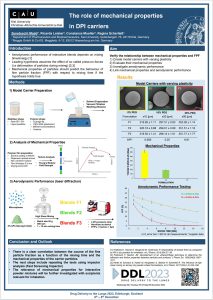The role of mechanical properties in DPI carriers

Introduction
- Aerodynamic performance of interactive blends depends on mixing time/energy
- Leading hypothesis assumes the effect of so called press-on-forces (i.e deformation of particles during mixing)
- Mechanical properties of particles should predict the behaviour of fine particle fraction (FPF) with respect to mixing time if the hypothesis holds true
Aim
Verify the relationship between mechanical properties and FPF
- Create model carriers with varying plasticity
- Evaluate their mechanical properties
- Investigate aerodynamic performance
- Link mechanical properties and aerodynamic performance
Methods
1) Model Carrier Preparation

2) Analysis of Mechanical Properties

Polymer film preparation
- Solvent casting in MeOH
- Dispersion spread across
- Non cohesive surface
- Film thickness 0.5 mm
- Drying period 24h
3) Aerodynamic Performance (laser diffraction)

Conclusion and Outlook
- There is a clear correlation between the course of the fine particle fraction as a function of the mixing time and the mechanical properties of the carrier particles
- The next steps include repeating the tests using impactor analysis (Fast Screening Impactor)
- The relevance of mechanical properties for interactive powder mixtures will be further investigated with excipients relevant for inhalation.
See the full poster on “The role of mechanical properties in DPI carriers” here
(click the picture to download the poster)
Source: MEGGLE poster “The role of mechanical properties in DPI carriers”, MEGGLE Excipients and the University of Kiel have joined forces to shed light on this interesting topic, Zeredescht Majid, Ricarda Leister, Constanze Mueller, Regina Scherließ
Do you need more information or a sample of MEGGLE excipients?


